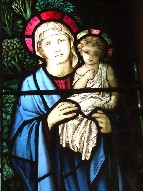| |
|
 |
|
You don't have to leave
Ipswich far behind to reach the most
profoundly rural of the villages of the
Shotley Peninsula, and this may come as a
surprise, because Freston Tower, of which
more in a moment, is a well-known
structure, and the Boot, the village pub,
is a familiar sight on the main Shotley
road along the north of the Peninsula.
The main village street runs off beside
it. But this soon becomes a narrow,
winding lane, rising and dipping between
high hedges, before reaching the surprise
of this church, and then beyond it a
pretty, largely 19th century settlement. Freston's is perhaps the
most harmonious of the three neighbouring
churches in this part of the Shotley
peninsula. Woolverstone may have the
finer setting, and Wherstead the grandest
aspect and most dramatic view. But
Freston's secretive graveyard is a
pleasing, peaceful place. As with its two
neighbours, this church was almost
entirely rebuilt by the Victorians, but
in a rather jaunty style, including an
Arts-and-Crafts-ish octagonal vestry on
the north side with a little chimney
above it. On the south side is the
surprise of the flamboyant wooden
life-size figure of Peace, holding her
laurel wreath high, and surmounting the
parish war memorial. She looks for all
the world as if she is on holiday here
from the main square of a small French
market town.
|
Not far off, the life-size
figure of a little boy, wearing a dress in the
Edwardian manner, rests smilingly beside a cross
on a grave. He is little Humphrey
Jervis-White-Jervis of Freston Hall, a member of
a family with a rather unusual triple-barreled
surname, who died at the age of 4 in 1900. He had
a younger sister who was born the same year that
he died. Her memorial is three along from his,
but a modern one, for she did not die until the
mid-1990s.
St Peter was a ruined shell by the 19th century.
One imagines the storms blowing in up the Orwell
each successive winter, gradually smoothing and
reducing its ragged flintwork, until nothing
would remain. However, the Anglican revival
prompted by the Oxford Movement saw its
restoration in 1875 by the local architect R.T.
Orr. He sensitively rescued the 15th century
tower, as well as several windows, including the
14th century east window. You can see Orr's plans
on display inside, beneath the tower.
The medieval font survives,
but that's about all. Given that the rest of the
interior is entirely Victorian, it is beautifully
atmospheric, with that haunting feeling you get
of the people who worshipped here when it was
renewed now being just out of reach. They have
left their memorials behind, and the best is a
figure of St Christopher by the William Morris
workshop. A curious survival of the past is the
enamelled sign explaining the significance of
Good Friday, which was propped up beneath the
tower.
When I first came
here twenty years ago, I found the church
locked without a keyholder notice, but
more recently there was a warm invitation
to get the key. Something similar
happened at Wherstead St Mary, a mile or
so off, a church with which St Peter
shares many similarities. Before leaving
Freston though, it is worth mentioning
that, rather unusually for a sleepy
Suffolk village, there are two buildings
here that are taller than the church.
Firstly, of course, there is the massive
water tower down on the Shotley Road.
But, beyond that, and more interestingly,
there is Freston Tower, in the grounds of
Freston Hall. This early 16th century
building is six storeys high, and the
tale goes that it was built as a school
for the daughter of Lord de Freston.
She was taught one lesson on each floor,
reaching the top in the evening, before
descending to the ground to begin a new
day. Actually, it was probably built as a
lookout tower, with a view of the estuary
mouth. But it's a good story, and you can
believe it if you like. There is, in any
case, a splendid view of the tower from
Bridge Wood on the far bank of the
Orwell. The river here seems to separate
two quite different Suffolks, and the
secretive Shotley Peninsula feels a place
apart, which in a sense it is. |
|
 |
|
|
|

